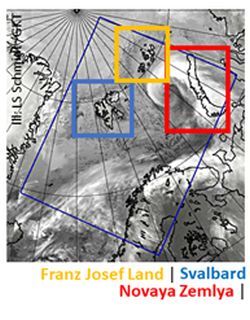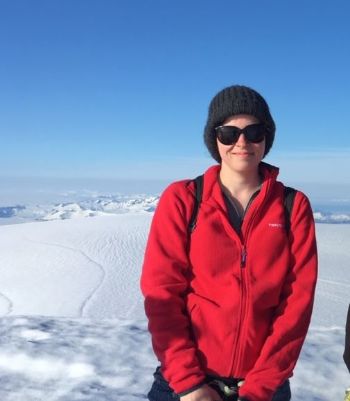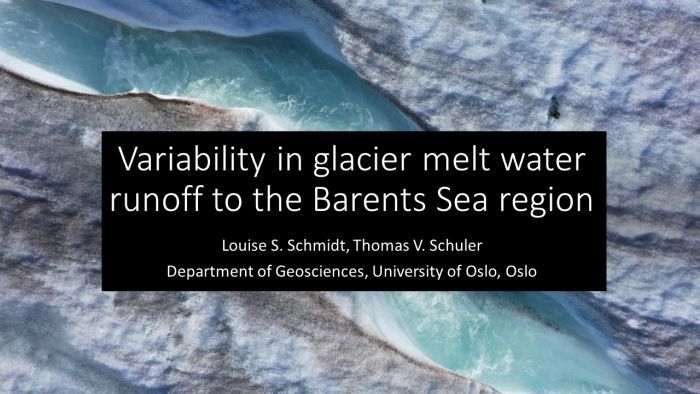The Barents Sea region has many glaciers located on islands and larger archipelagos. Glaciers that store a lot of freshwater. Every year, the glaciers receive a varying degree of snow that helps to maintain the glacier mass.
The enormous volume of freshwater represented by these glaciers is a major source of meltwater runoff to the Barents Sea. This runoff is of interest to The Nansen Legacy project, since the meltwater provides iron, creates circulation between water layers with different densities, temperatures type of water; freshwater or seawater within the seawater masses, and provides nutrients to the food chain.
 The hydrological cycle of glaciers, snow accumulation, and meltwater runoff to the sea is what Postdoc Louise Steffensen Schmidt and Prof. Thomas Vikhamar Schuler are going to model. Both are at the Department of Geosciences, UiO.
The hydrological cycle of glaciers, snow accumulation, and meltwater runoff to the sea is what Postdoc Louise Steffensen Schmidt and Prof. Thomas Vikhamar Schuler are going to model. Both are at the Department of Geosciences, UiO.
– More precisely, our assignment is to calculate variation in runoff of meltwater from three land areas; the archipelagos of Svalbard and Franz Josef Land, and on the Russian double island of Novaya Zemlya, Louise explains.
Variations in meltwater runoff
To get an answer to the issue of meltwater runoff, she has programmed a climate model that is based on a geographical grid, the Norwegian-developed model CryoGrid (Westermann et.al.).
– CryoGrid is a land surface model that was developed to simulate ground temperatures in permafrost environments. The model has been adapted to also cover mass balance simulations of glaciers. The model handles weather data, humidity data, energy fluxes to the land surface, and precipitation. The representation of runoff to the sea in the model is determined by delimiting the drainage basins using the Matlab model TopoToolbox.
The models are operational and Louise now has a 4-year time series from 2016 to 2020 with data for runoff from the three meltwater regions that are being investigated.
– The simulations of the model already reveal variations in runoff from land and glaciers for the three study areas; the archipelagos of Svalbard, Franz Josef Land and Novaya Zemlya. But we need more years and more data back in time to study the degree of variation and the trend direction.
Almost finished with her programming work, Louise is now waiting for the CARRA-EAST dataset from the Norwegian Meteorological Institute to become available. This dataset has weather data from 1997 to today for the High North, and will be used for reanalysis of the established model of Louise et al.
Louise Steffensen Schmidt's role in The Nansen Legacy project
Schmidt has been employed as a postdoctoral fellow at the Department of Geosciences, University of Oslo since the autumn of 2019. She is part of the Section for Geography and Hydrology (GeoHyd).

In the Nansen Legacy project she participates in the work package RF1: Natural Drivers. Here she is working with Professor Thomas Vikhamar Schuler on the project to estimate melt runoff for the Barents Sea region.
Louise comes from Denmark, from the city of Copenhagen. Her interest in climate, calculations and the link between the glaciology/cryosphere and hydrology, has developed gradually since she was first inspired in high school after participating in a "Forskerspire" – Research experience programme for students. There she worked with iceberg cores from Greenland, and became fascinated by what they could tell about the climate back in time.
The interest in climate and science led her to study physics at the Nils Bohr Institute, University of Copenhagen, and later she gained a PhD in Geophysics from the University of Iceland, and now Department of Geosciences, University of Oslo. Her research interests are mass balance in glaciers, dynamics of/in glaciers, and climate models.
This article has also been published at The Nansen Legacy`s webpages ...
